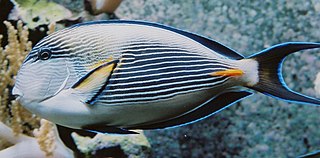
Acanthuridae are a male to female the family of surgeonfishes, tangs, and unicornfishes. The family includes about 86 extant species of marine fish living in tropical seas, usually around coral reefs. Many of the species are brightly colored and popular in aquaria.
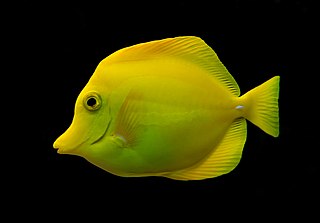
The yellow tang, also known as the lemon sailfin, yellow sailfin tang or somber surgeonfish, is a species of marine ray-finned fish belonging to the family Acanthuridae which includes the surgeonfishes, unicornfishes and tangs. It is one of the most popular marine aquarium fish. It is bright yellow in color, and it lives in reefs. The yellow tang spawn around a full moon. The yellow tang eats algae. The yellow tang has a white barb, located just before the tail fin, to protect itself.

Acanthurus is a genus of marine ray-finned fish belonging to the family Acanthuridae, which includes the surgeonfishes, unicornfishes and tangs, found in the Atlantic, Indian and Pacific Ocean. They are found in tropical oceans, especially near coral reefs, with most species in the Indo-Pacific but a few are found in the Atlantic Ocean. As other members of the family, they have a pair of spines, one on either side of the base of the tail which are dangerously sharp.

The sohal surgeonfish or sohal tang, is a species of marine ray-finned fish belonging to the family Acanthuridae, which includes the surgeonfishes, unicornfishes and tangs. This fish is found in the northwestern Indian Ocean.
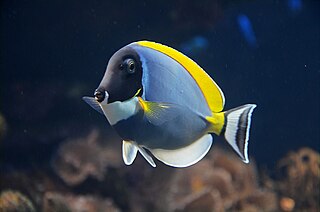
Acanthurus leucosternon, commonly known as the blue surgeonfish, powder blue tang or powder-blue surgeonfish, is a species of marine ray-finned fish belonging to the family Acanthuridae, the surgeonfishes, unicornfishes and tangs. This species is found in the Indian Ocean.

Acanthurus coeruleus is a species of marine ray-finned fish belonging to the family Acanthuridae, the surgeonfishes, unicornfishes and tangs, found in the Atlantic Ocean. It can grow up to 39 centimetres (15 in) long. Common names include Atlantic blue tang, blue barber, blue doctor, blue doctorfish, blue tang, blue tang surgeonfish, yellow barber, and yellow doctorfish.

The doctorfish tang, also known as the doctorfish, is a species of marine ray-finned fish belonging to the family Acanthuridae, the surgeonfishes, unicornfishes and tangs. These fishes are found in the western Atlantic Ocean.
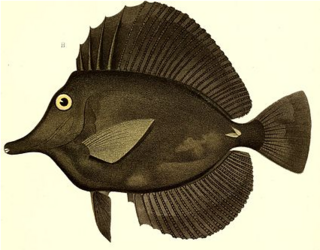
Zebrasoma rostratum, the longnose surgeonfish, longnose tang or black tang, is a species of marine ray-finned fish belonging to the family Acanthuridae, which includes the surgeonfishes, unicornfishes and tangs. This fish is found in the western central Pacific Ocean.

Acanthurus olivaceus, the orange-band surgeonfish, the orange-shoulder surgeonfish or the orangebar tang, is a species of marine ray-finned fish belonging to the family Acanthuridae, this family includes the surgeonfishes, unicornfishes and tangs. It lives in the tropical waters of the Indo-west Pacific.

Zebrasoma scopas, the brown tang, twotone tang, scopas tang or brush-tail tang, is a species of marine ray-finned fish belonging to the family Acanthuridae which includes the surgeonfishes, unicornfishes and tangs. The brown tang is found throughout Oceania and is a herbivorous fish, feeding predominantly on filamentous algae. It is a highly popular fish in the aquarium trade.

The sailfin tang, the Pacific sailfin tang, purple sailfinned tang or sailfin surgeonfish, is a marine ray-finned fish belonging to the family Acanthuridae which includes the surgeonfishes, unicornfishes and tangs. This fish is found in the Pacific Ocean and is popular in the aquarium hobby.

Acanthurus dussumieri, commonly known as Dussumier's surgeonfish, the eye-stripe surgeonfish or the ornate surgeonfish, is a ray-finned fish from the Indo-Pacific. It occasionally makes its way into the aquarium trade. It grows to a maximum length of 54 cm (21 in) but 35 cm (14 in) is a more usual size.
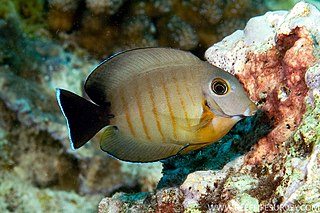
Acanthurus tristis, the Indian Ocean mimic surgeonfish, blackcheek surgeonfish or yellowspot surgeonfish, is a species of marine ray-finned fish belonging to the family Acanthuridae which includes the surgeonfishes, unicornfishes and tangs. This species is found in the eastern Indian Ocean.

Acanthurus japonicus, the Japan surgeonfish, white-faced surgeonfish, gold rim tang, powder brown tang and white-nose surgeonfish, is a species of marine ray-finned fish belonging to the family Acanthuridae, the surgeonfishes, unicornfishes or tangs. This fish is found in the Western Pacific Ocean.

Acanthurus nigrofuscus, the brown surgeonfish, blackspot surgeonfish, brown tang, dusky surgeon, lavender tang or spot-cheeked surgeonfish, is a species of marine ray-finned fish belonging to the familyAcanthuridae, which includes the surgeonfishes, unicornishes and tangs. This species is a common and abundant fish occurring across a wide Indo-Pacific range.
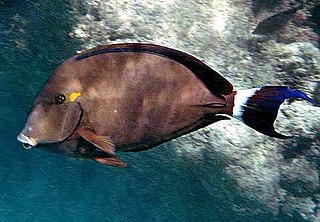
Acanthurus blochii, the ringtail surgeonfish or dark surgeonfish, is a marine ray-finned fish belonging to the family Acanthuridae, the surgeonfishes, unicornfishes and tangs. This fish is found in the Indo-Pacific.

The doubleband surgeonfish or lieutenant tang, is a marine ray-finned fish in the family Acanthuridae. It is found in the tropical and sub-tropical Indo-Pacific region and grows to a maximum length of 31 cm (12 in).
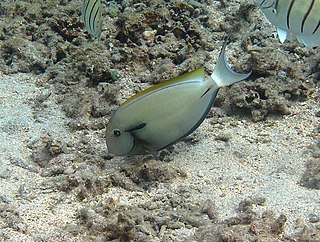
Acanthurus nigricauda, the epaulette surgeonfish, black-barred surgeonfish, eye-line surgeonfish, shoulderbar surgeonfish, white-tail surgeonfish or blackstreak surgeonfish, is a species of marine ray-finned fish belonging to the family Acanthuridae, the surgeonfishes, unicornfishes and tangs. It is native to the Indo-Pacific region.

Acanthurus fowleri, Fowler's surgeonfish or the horseshoe surgeonfish, is a species of marine ray-finned fish belonging to the family Acanthuridae, the surgeonfishes, unicornfishes or tangs. This fish is found in the Western Pacific Ocean.

Acanthurus thompsoni, the night surgeonfish, chocolate surgeonfish, Thompson's surgeonfish, Thompson's tang or whitetail surgeonfish, is a species of marine ray-finned fish belonging to the family Acanthuridae which includes the surgeonfishes, unicornfishes and tangs. This species has a wide Indo-Pacific distribution.




















